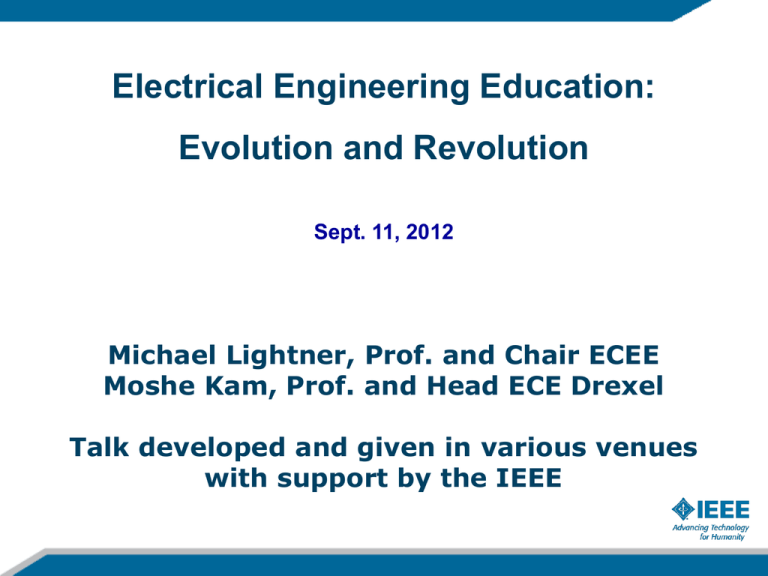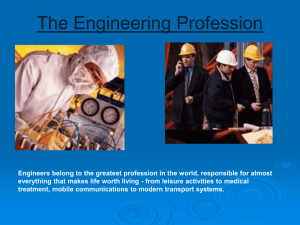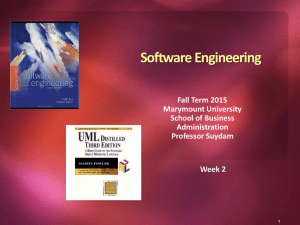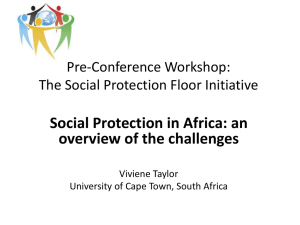Electrical Engineering Education
advertisement

Electrical Engineering Education: Evolution and Revolution Sept. 11, 2012 Michael Lightner, Prof. and Chair ECEE Moshe Kam, Prof. and Head ECE Drexel Talk developed and given in various venues with support by the IEEE 2 Outline Caveats and disclaimers Engineering education and previous reforms Evolution – The fundamentals may be shifting – The profession is changing Geographically In relation with other disciplines In terms of products and services In the nature of the workplace Revolution – The tsunami facing higher education At least in the US 3 Caveats and Disclaimers Omitting discussion of education outside the US Not presenting discussion of the many advances in pedagogy and learning science Not providing answers, but raising issues and pointing out pressures This is just a sampling, there are many more examples, apologies if your favorite is not included AND – it will be a race through a wide range of material 10 The Beginning of Engineering Education By the mid-1600s, artillery and fortifications had grown so complex that European armies began training officers in math and mechanics The term “Engineer” has been in use (in the current sense) only for the last 200 years Engineering education was formalized in France – School of Bridges and Highways, 1775 (Jean Parronet) – École Polytechnique, 1794 (Lazare Carnot and Gaspard Monge) 11 First Engineering Schools in the US Revolutionary America had to rely on Civil Engineers from Europe for major projects In 1802 the Army established the U.S. Military Academy at West Point to train artillery and engineering officers Sylvanus Thayer, commandant after 1817, transformed West Point into the nation's first engineering school by copying the École Polytechnique After 1825 courses in Civil Engineering were became available in Washington College, Princeton, New York University, and Vanderbilt RPI (1828); University of Virginia (1833) http://www.answers.com/topic/engineering-education-1#ixzz1CZzjL7Fn 11 12 EE education in the US and Europe: the first 50 years in a glance Early EE departments were established in the last 20 years of the 19th century – Most grew out of Physics departments – Curricula focused on AC and DC circuits and power distribution – B.Sc. Degree was the norm for faculty Plus hands-on training in industry – After World war I communication options appear – Little academic research In 1925 only one MIT EE faculty member had a Ph.D. Half of the faculty had a B.Sc degree + practical experience Terman 1976 13 The Impact of World War II The rise of new technology found the field unprepared – Most “EE work” was performed by scientists from other disciplines, especially Physics – Radar, microwaves, control systems, guided missiles, proximity fuses The case was reform was clear Terman 1976 14 The First Reform (1945-1955) Overhaul of textbooks and courses – A new book shelf Focus on the fundamentals Impetus for reform: new technology – Mathematics and Physics – Introducing Physics-based Calculus as the basic first step of the engineering curriculum De-emphasis of classes on “engineering practice” and apprenticeship – Drafting, surveying, practicum Terman 1976 15 The First Reform (1945-1955) Large expansion of graduate programs – Beginning of federal funding of academic engineering research Emergence of new requirements and expectations from engineering faculty members – At least an M.S. degree – In many institutions – demonstration of ability to conduct independent research Educate new Ph.D. students Obtain external support for research Painful transition in many institutions 16 The emergence and rise of graduate programs in engineering 1960-1975 Significant growth in the number of graduate engineering programs Differentiation between the objective and nature of MS and PhD programs The impact of strong graduate programs is being felt in industry… – Strong graduate programs start developing their own industries In 1962 the first US Computer Science program is established 17 High Tech Industry is linked to availability of strong and well-trained engineer corps Silicon Valley would not exist without Stanford University and the University of California, Berkeley Boston Route 128 would not be possible without MIT and Harvard Austin’s Silicon Gulch is there because of the University of Texas – Austin DSP Valley is around the University of Leuven, Belgium Kansai Science City is linked to Osaka University Numerous examples in China 18 The “Axioms” The post-WWII model of interlinked teaching and research in engineering academic programs continues to be dominant around the world – The best “stand-alone” research labs continue to have strong links to universities The connection between engineering and economic development has now become axiomatic both in developed and developing countries – A key justification for continued support of engineering programs 19 Differentiation and Compartmentalization 1975-1985 Many engineering programs develop “tracks” – Often available only in the Senior year – EE: “Signal processing” “Power and Control” “Biomedical Devices” “Computers” “Antennas and Propagation” Computer Engineering programs proliferate – The emergence of the ECE department ‘Secession’ of Computer Science is complete New programs emerge in Biomedical Engineering 20 The impetus for the second US reform (1990-2003) Desire to use emerging technology to improve instruction – Personal computer, digital communication and networking – The sense that the pendulum has swung too much toward Engineering Science High attrition rate of students in the early years – Attributed to the abstract nature of preparatory classes – in US only slightly more than 50% of students entering engineering graduate with an engineering degree Graduates perceived to be deficient in communication and presentation skills Serov 1997 21 The impetus for the second US reform (1990-2003) Graduates perceived to be unable to take into consideration economic, social, and ethical considerations; can’t work in teams Increased economic gap between engineering and practitioners of the ‘professions’ Continued failure to attract minorities and women to engineering A plethora of new proposals for better pedagogical approaches for engineering Serov 1997 22 General Outline of the Second Reform in the US Started with the 1988 NSF-funded E4 experiment at Drexel University Continued by establishment of NSF coalitions of schools, which operated 1992-2002 – Gateway, SUCCEED The coalitions developed new curricular materials, ideas and structures – Implementation and scaling proved difficult – Adoption of coalition-created instructional material and methods outside home institutions was limited 23 Formalization of Second Reform in US ABET Engineering Criteria 2000, EC 2000 was the formalization of the concerns of the second reform Maintain high level of engineering science while including/emphasizing new elements … – – – – – – Team work Capstone design Ethics and societal impact Globalization Communication Quality control assessment/feedback mechanisms 27 Impetus for a Third Reform - Evolution The fundamentals may be shifting – Modern computing is not integrated properly in engineering education – Life sciences becoming more important – Web 2.0 and internet causing fundamental shifts The profession is changing – – – – Geographically In relation with other disciplines In terms of products and services In the nature of the workplace The economic and demographic problems of the profession have not been solved Impetus for a Third Reform The Fundamentals may be shifting – Modern computing is not integrated properly in engineering education Computing is Changing the Nature of Engineering Work The use of computing tools has pervaded almost all areas of engineering – Look under the hood of your car – Look under the hood of your Spectrum Analyzer Engineering education did not yet catch up – For us it is still “computer aided design” – For industry this is the only design that there is We continue to teach many subjects as if symbolic computation and computers do not exist 29 30 A Few Examples We continue to teach again and again how to find, guess and synthesize integrating factors We still teach students how to use approximations and rules of thumb most of which will never ever be used – Think about Bode Plots and Root Locus Methods – How about Karnaugh maps Fundamentals of software writing and software testing are often left for self exploration – And yet these are of increasing significance for engineers on the job 31 Cloud Computing Obvious impacts – Change CS/IT education to understand requirements for cloud implementations – Institutions using cloud-based approaches for email, learning management systems, social computing Non-obvious impacts – Data, both large and small, from real sources allow new, real world, authentic problems to be explored at all levels of engineering education – Resources available globally reducing barriers to access 32 Key Argument Against Increased Emphasis on Computing (1) Rules of thumb provide insight and intuition for design (2) Simply running a program provides no intuition But… the students coming from high school seem to have ever decreasing skills in algebraic manipulation – Rules of thumb come from doing ‘algebraic’ manipulation to reduce problem size and understand patterns We need new ways of teaching that use symbolic and numerical computation but still generate insight and intuition for design 33 Computing vs. Programming (1) Computing, herein, refers to use of specialized packages for computing certain results and for symbolic manipulation – Could be within more general packages such as Matlab, Mathematica, Alpha, LTSpice – Allows larger and real world problems to be done by students – Obviates the need for many specialized techniques that reduce dimensionality of large problems Students need to use these computational tools as tools to think with, not just tools to complete an assignment 34 Computing vs. Programming (2) Programming focuses on developing code for particular purposes – An important discipline and skill which is not taken seriously enough in most current engineering curricula – The erroneous assumption is that this is an add-on that students can learn on their own – Another erroneous assumption is that programming for production is not done by engineers 35 One Possible Reaction: Keep Computing to the Computer Scientists! This view neglects the fact that for many engineers proficiency in computing and programming is no less fundamental nowadays than proficiency in Physics-Based Calculus 36 A More Reasoned Approach The role of computing in the education of engineers needs to be re-thought Computing skills can no longer be add-ons and nice-to-haves As analytical skill needed by engineers, computing may have become as least as fundamental as Calculus Impetus for a Third Reform The Fundamentals may be shifting – Integrating Life Sciences into the ECE Curricula 38 Intersection of Life Sciences & ECE Data and Image analysis – Medical Image analysis – All the –omics (genomics, proteomics, glucomics, etc) Optics and advanced microscopy Telemedicine/Telehealth Health Informatics Prostheses – Robotics, cognitive, sensory (cochlear, visual) In vivo sensors Biochips Bionanophotonics 39 Student Interest Significant student interest in bio-x engineering – Bioengineering, biomedical engineering, biological engineering Other departments are pushing strongly into these areas – – – – Biomedical and Bioengineering departments Mechanical engineering departments Chemical engineering departments Biological engineering departments ECE often challenged to have significant bio-presence in the curriculum 40 Research Challenges Major interdisciplinary efforts on campuses and in companies. Significant funding and opportunity for growth, but only if part of the team EE/ECE departments need to encourage students and faculty to participate – Introduce life sciences courses – Create and hire faculty with different sets of interests 41 One Possible Reaction: Keep your microbes to yourself – earthling! 42 A More Reasoned Approach Provide ECE students with education in the life sciences Develop minors and double majors Encourage capstone experiences in life science related projects Partner with other disciplines Develop joint faculty appointments 43 And there is more … New approaches to education in Power and Energy Engineering as enhancer of quality of life – Entertainment engineering, media, games Grand Challenge Problems in the curriculum Impetus for a Third Reform The Profession is Changing… –Geographically 45 Our Profession is Changing Geographically Science and engineering education is expanding into new geographical areas Some engineering work has migrated from its former US and West European centers to other countries and regions Manufacturing, Design, Research and Development are performed in many countries that had no Hi-tech industry even 20 years ago – But not without significant improvement in graduate education First University Degrees in Selected Areas 1800000 1600000 1400000 1200000 1000000 800000 600000 400000 200000 0 http://www.nsf.gov/statistics/seind08/c2/c2s5.htm Science and Engineering Indicators 2008 (US NSF) Asia Europe North/Central America 47 S&E degree as fraction of the total number of degrees granted In the United States, S&E degrees are about one-third of U.S. bachelor’s degrees (and much lower for engineering alone) In several countries more than half of first university degrees were in S&E – Japan (63%), China (56%), Singapore (59%), Laos (57%), Thailand (69%) Science and Engineering Indicators 2008 (US 48 Degrees in Engineering In the United States, about 5% of all bachelor’s degrees are in engineering In most of Asia, 20% of the degrees are in engineering – In China, the number of first university degrees in engineering more than doubled between 2000 and 2004 and quadrupled over the past two decades In many other countries worldwide, more than 10% of the degrees are in engineering Science and Engineering Indicators 2008 (US NSF) 49 Older Players experiences difficulties: Full Time Undergraduate Enrollment in ECE Programs in the US 120000 100000 80000 60000 40000 20000 0 Source: ASEE 2002 2003 2004 2005 2006 2007 2008 2009 53 A Global Challenge Educate future engineers to work in a transnational environment – E.g., encourage “a semester abroad” and exchange programs – Introduce pertinent international trends into the curriculum Including education in business and law Provide resources to engineers to understand industrial and economical trends that affect the profession Develop a global system of credential and accreditation recognition Impetus for a Third Reform The Profession is Changing… –The Rise of the Service Economy 55 56 The Role of Service Economy is Increasing Increased importance of the service sector in industrialized economies Look at the Fortune 500 – …more service companies – …fewer manufacturers The old dichotomy between product and service has been replaced by a serviceproduct continuum 57 “Servitization of products” Today we have the commodization of our products tomorrow we will have the servitization of our products Products today have a higher service component than in previous decades Virtually every product today has a service component to it Many products are being transformed into services 60 One Possible Reaction: This is Beneath Us… Service is NOT Engineering 61 A More Reasoned Approach Recognize that the Service Economy is here to stay Find ways to integrate the Service Economy in the Engineering curriculum Re-examine interdisciplinary work in Commerce and Engineering – This may be the right time for another look Impetus for a Third Reform The Profession is Changing… –with respect to other disciplines Our Profession is Expanding Beyond Traditional Departments Here are a few courses taught by the Mechanical Engineering Department in Lehigh University: – Control Systems – Digital Control – Control Systems Laboratory – Mechatronics – Mechatronics Laboratory – Nuclear Reactor Engineering Mechanical Engineering Laboratory – Introduction to elementary instrumentation. Introduction to digital data acquisition. – Including use of transducers, advanced instrumentation, and data acquisition. Kidnapping of the Leukipp's Daughters Our Profession is Expanding Beyond Traditional Departments Here are a few courses taught by the Mechanical Engineering Department in Lehigh University: – Control Systems – Digital Control – Control Systems Laboratory – Mechatronics – Mechatronics Laboratory – Nuclear Reactor Engineering Mechanical Engineering Laboratory – Introduction to elementary instrumentation. Introduction to digital data acquisition. – Including use of transducers, advanced instrumentation, and data acquisition. This looks like EE to me!! Kidnapping of the Leukipp's Daughters Our Profession is Expanding Beyond Traditional Departments Here are a few courses taught by the Biomedical Engineering Department in Georgia Tech: – Introduction to Signal Processing – Biomedical Systems and Modeling – Computing for Engineers – Biomedical Instrumentation – Introduction to Medical Image Processing Biomedical Systems and Modeling – Systems and Modeling – Linear-Systems Analysis in the Time Domain – Linear-Systems Analysis in the Laplace Domain – Linear-Systems Analysis in the Frequency Domain – Control Systems Design and Analysis Our Profession is Expanding Beyond Traditional Departments Here are a few courses taught by the Biomedical Engineering Department in Georgia Tech: – Introduction to Signal Processing – Biomedical Systems and Modeling – Computing for Engineers – Biomedical Instrumentation – Introduction to Medical Image Processing This looks like EE to me!! Biomedical Systems and Modeling – Systems and Modeling – Linear-Systems Analysis in the Time Domain – Linear-Systems Analysis in the Laplace Domain – Linear-Systems Analysis in the Frequency Domain – Control Systems Design and Analysis 67 Enrollment is not an Engineering Wide Problem US Mechanical engineering enrollment is at historical highs – ME appears broad and relevant – Aggressive, expansion into electomechanics, robotics, bio-mechanics and nanotechnology Civil engineering growing rapidly Aerospace and Bio programs growing well Mechanical and Chemical departments are claiming the Energy space 68 The Case for Curricular Reform The fundamentals may be shifting – The impact of modern computing is not yet integrated in engineering education – Integration of life sciences into ECE curricula The profession is changing – Geographically – In relation with other disciplines – In terms of products and services – In the nature of the workplace The economic and demographic problems of the profession have not been solved Unexplored here is the ever increasing understanding of how people learn and the impact that understanding has on how we support that learning with our university offerings – notice I did not say teaching 69 Revolution Collective learning New tools changing the idea of labs Internet and Machine Learning are providing the basis for revolutionary changes in higher education, with engineering and computer science as the clear first targets This is made even more compelling as more is known about how we learn – Note that we professors are the best model for didactic learning – after all we succeeded in the traditional system – Can be hard for us to accept new perspectives – seems like either coddling the students or cheating 70 Collective Learning Solutions to all textbook problems available online Many blogs and forums on engineering topics more responsive and informative than professors and TAs Makers movement – Online communities using tools such as Arduino, small embedded processors, 3D printers, and more – Authentic communities supporting the design and building of exciting projects – Much more engaging than typical university labs 71 National Instruments MyDAQ A lab in your pocket – EE, ME, Control…. 72 MyDAQ 73 Altera DE0-Nano 74 Arduino Simple and inexpensive microcontroller MANY peripherals (shields) HUGE community of hobbyists Great online help Collective learning - MOOCs Challenges from for-profit institutions Challenges from certificate programs If continuous education is the norm for a working professional, how does that manifest in the classroom? Is the lecture still relevant? The classroom? Important reading (there are many more) – A New Culture of Learning: Cultivating the Imagination for a World of Constant Change Douglas Thomas, John Seely Brown – From Abelard to Apple, Richard DeMillo. – DIY U: Edupunks, Edupreneurs, and the Coming Transformation of Higher Education Anya Kamenetz – Disrupting the Classroom: How Disruptive Innovation Can Deliver Quality and Affordability to Postsecondary Education, Clayton M. Christensen, Michael B. Horn, Louis Caldera, Louis Soares, Innosight Institute, Feb 2011 75 76 76 3/24/2016 77 77 3/24/2016 78 78 3/24/2016 79 79 3/24/2016 80 80 3/24/2016 81 81 3/24/2016 82 82 3/24/2016 83 83 3/24/2016 84 84 3/24/2016 85 85 3/24/2016 86 86 3/24/2016 87 87 3/24/2016 88 88 3/24/2016 89 89 3/24/2016 90 91 92 93 94 95 96 96 3/24/2016 97 98 Flipped classroom 99 100 100 3/24/2016 101 101 3/24/2016 102 What will happen? Evolution and Revolution We will evolve – already seeing changes in undergraduate programs – Math/computing still has a long way to go – Mixing disciplines more likely, especially in bio areas – Labs will become much more personal There will be a revolution – Why lecture when you can have an interactive class? Students get lecture from the web – flipped classroom Problems/HW, labs, designs, all supported locally – Labs and design teams can be more global Grades and degrees given locally – Could see professional organizations offering some type of degree or certification based on testing material learned online 103 The Flipped Classroom Interactive Learning Online at Public Universities: Evidence From Randomized Trials The study compared how much students at six public universities learned after taking a prototype introductory statistics course in the fall of 2011 in either a hybrid or a traditional format. Randomly assign a diverse group of 605 students to either – a hybrid group, with computer-guided instruction and one hour of face-to-face instruction each week, – or a traditional format, with three or four hours of face-to-face instruction per week. 104 The Flipped Classroom The result? “We find that learning outcomes are essentially the same—that students in the hybrid format pay no ‘price’ for this mode of instruction in terms of pass rates, final exam scores, and performance on a standardized assessment of statistical literacy,” Purdue has conducted similar experiments for a number of years – Essentially no difference, except, students in the flipped classroom performed better on more demanding conceptual problems than those in the traditional classroom What will happen? Prediction – engineering education in 2020 will look quite different than it does today. Changes? – MS degrees – radically changed done online from many sources with a variety of assessments – even from IEEE??? – Lecturers in large undergrad courses challenged by available online lectures Flipped classroom becomes common Student communities become global – Personal labs become more common Online help, and hobbyist communities become an integral part of basic engineering education – Role of, and economic value of, many universities will be called into question 105 106 What will happen? At least 25 years ago I asked how many research universities were needed in the US – I posited that the answer was certainly less than 50 and that anymore was diluting the critical mass of dollars, researchers and graduate students needed for major progress – Of course we have more than 50 research universities, and everyone claims that they are doing or require research The changes in content and especially delivery that we surveyed today with the economic challenges facing most of the globe could cause a profound change in the landscape and focus of universities in the US and perhaps globally 107 What do Universities provide? Collection of experts Community of learners Expensive labs Definition of Degrees Face-to-face interactions Gateway to Industry and Profession Sanctioned Validation of Success 108 What part of Universities cannot be replaced? Collection of experts Expensive labs Community of learners Definition of Degrees Face-to-face interactions Gateway to Industry and Profession Validation of Success 109 We Live in Exciting Times 110 We Live in Exciting Times Thank you Questions and Comments…




